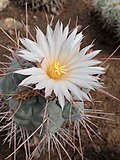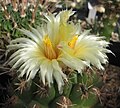
Echinocactus is a genus of cacti in the subfamily Cactoideae. The generic name derives from the Ancient Greek ἐχῖνος (echînos), meaning "spiny," and cactus. It and Ferocactus are the two genera of barrel cactus. Members of the genus usually have heavy spination and relatively small flowers. The fruits are copiously woolly, and this is one major distinction between Echinocactus and Ferocactus. Propagation is by seed.

In 1984, the International Organization for Succulent Plant Study set up a working party, now called the International Cactaceae Systematics Group, to produce a consensus classification of the cactus family, down to the level of genus. Their classification has been used as the basis for systems published since the mid-1990s. Treatments in the 21st century have generally divided the family into around 125–130 genera and 1,400–1,500 species, which are then arranged in a number of tribes and subfamilies. However, subsequent molecular phylogenetic studies have shown that a very high proportion of the higher taxa are not monophyletic, i.e. they do not contain all of the descendants of a common ancestor. As of August 2023, the internal classification of the family Cactaceae remained uncertain and subject to change. A classification incorporating many of the insights from the molecular studies was produced by Nyffeler and Eggli in 2010.
Neolloydia is a formerly recognized genus of cacti. The genus was first erected by Britton and Rose in 1922. Edward F. Anderson regarded Neolloydia as being poorly defined, with the result that species that had at times been included in Neolloydia were afterwards placed in multiple genera, including Coryphantha, Echinomastus, Escobaria, Mammillaria, Sclerocactus, Thelocactus and Turbinicarpus. In his 2001 book, Anderson firmly placed only one species in the genus, Neolloydia conoidea, with another, Neolloydia matehualensis, being regarded as only a variant of N. conoidea. As of December 2022, Plants of the World Online treated Neolloydia conoidea as a synonym of Cochemiea conoidea, and Neolloydia as a synonym of Cochemiea.
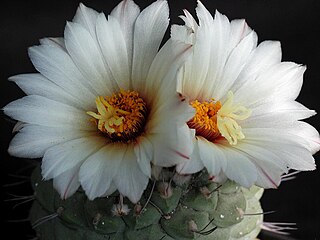
Strombocactus disciformis is a rare species of cacti and the only species of the genus Strombocactus. The plant originates from Central and Northeast Mexico.

Turbinicarpus is a genus of very small to medium-sized cacti, which inhabit the north-eastern regions of Mexico, in particular the states of San Luis Potosí, Guanajuato, Nuevo León, Querétaro, Hidalgo, Coahuila, Tamaulipas and Zacatecas.

Pilosocereus is a genus of cactus native to the Neotropics. Tree cactus is a common name for Pilosocereus species. The genera Caerulocereus and Pseudopilocereus are synonyms of this genus.

Mila caespitosa is a species of cacti and the only species of the genus Mila. Its generic name is an anagram of Lima, Peru, the city near which the plant is found. The genus was first thought to comprise 13 species, until recent studies suggest they form one very variable species.

Weingartia is a genus in the family Cactaceae, with species native to Bolivia and Argentina. Molecular phylogenetic evidence suggests that it may be distinct from Rebutia. It is treated as a synonym of that genus by Plants of the World Online as of September 2023, but recognized as an alternative generic name in the third edition of the CITES Cactaceae Checklist. It may also be treated as Rebutia subg. Weingartia.

Cacteae is a tribe of plants of the family Cactaceae found mainly in North America especially Mexico. As of August 2018, the internal classification of the family Cactaceae remained uncertain and subject to change. A classification incorporating many of the insights from the molecular studies was produced by Nyffeler and Eggli in 2010. The main threats to cactus species are poaching, farming, mining developments, and climate change.

Kadenicarpus horripilus is a species of plant in the family Cactaceae.

Rapicactus mandragora, synonym Turbinicarpus mandragora, is a species of plant in the family Cactaceae.

Turbinicarpus pseudopectinatus is a species of plant in the family Cactaceae.
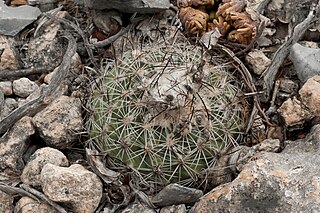
Turbinicarpus saueri is a species of plant in the family Cactaceae.

Turbinicarpus schmiedickeanus is a species of plant in the family Cactaceae.
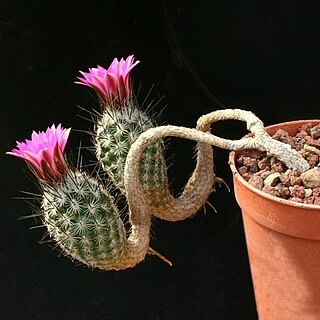
Rapicactus subterraneus, synonym Turbinicarpus subterraneus, is a species of plant in the family Cactaceae. It is endemic to Mexico. Its natural habitat is hot deserts.

Thelocactus hexaedrophorus is a species of cactus. It is endemic to Mexico.

Thelocactus rinconensis, synonyms including Thelocactus nidulans, is a species of cactus. It is endemic to north-east Mexico.

Thelocactus bicolor, the glory of Texas, is a species of flowering plant in the cactus family, widely distributed in the northern Chihuahuan Desert of Texas and Mexico.
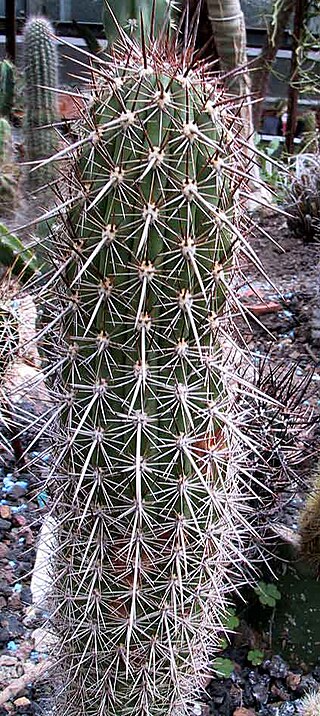
Haageocereus platinospinus is a species of Haageocereus found in Peru.

Echinocereus viereckii is a species of cactus native to Mexico.






